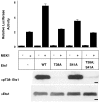Ras signaling requires dynamic properties of Ets1 for phosphorylation-enhanced binding to coactivator CBP
- PMID: 20534573
- PMCID: PMC2890480
- DOI: 10.1073/pnas.0915137107
Ras signaling requires dynamic properties of Ets1 for phosphorylation-enhanced binding to coactivator CBP
Abstract
Ras/MAPK signaling is often aberrantly activated in human cancers. The downstream effectors are transcription factors, including those encoded by the ETS gene family. Using cell-based assays and biophysical measurements, we have determined the mechanism by which Ras/MAPK signaling affects the function of Ets1 via phosphorylation of Thr38 and Ser41. These ERK2 phosphoacceptors lie within the unstructured N-terminal region of Ets1, immediately adjacent to the PNT domain. NMR spectroscopic analyses demonstrated that the PNT domain is a four-helix bundle (H2-H5), resembling the SAM domain, appended with two additional helices (H0-H1). Phosphorylation shifted a conformational equilibrium, displacing the dynamic helix H0 from the core bundle. The affinity of Ets1 for the TAZ1 (or CH1) domain of the coactivator CBP was enhanced 34-fold by phosphorylation, and this binding was sensitive to ionic strength. NMR-monitored titration experiments mapped the interaction surfaces of the TAZ1 domain and Ets1, the latter encompassing both the phosphoacceptors and PNT domain. Charge complementarity of these surfaces indicate that electrostatic forces act in concert with a conformational equilibrium to mediate phosphorylation effects. We conclude that the dynamic helical elements of Ets1, appended to a conserved structural core, constitute a phospho-switch that directs Ras/MAPK signaling to downstream changes in gene expression. This detailed structural and mechanistic information will guide strategies for targeting ETS proteins in human disease.
Conflict of interest statement
The authors declare no conflict of interest.
Figures




Similar articles
-
The PNT domain from Drosophila pointed-P2 contains a dynamic N-terminal helix preceded by a disordered phosphoacceptor sequence.Protein Sci. 2012 Nov;21(11):1716-25. doi: 10.1002/pro.2151. Epub 2012 Oct 9. Protein Sci. 2012. PMID: 22936607 Free PMC article.
-
Ras/mitogen-activated protein kinase signaling activates Ets-1 and Ets-2 by CBP/p300 recruitment.Mol Cell Biol. 2004 Dec;24(24):10954-64. doi: 10.1128/MCB.24.24.10954-10964.2004. Mol Cell Biol. 2004. PMID: 15572696 Free PMC article.
-
Phosphorylation of an intrinsically disordered segment in Ets1 shifts conformational sampling toward binding-competent substates.Structure. 2014 Aug 5;22(8):1196-1203. doi: 10.1016/j.str.2014.06.002. Epub 2014 Jul 10. Structure. 2014. PMID: 25017730
-
The role of the transcription factor Ets1 in carcinoma.Semin Cancer Biol. 2015 Dec;35:20-38. doi: 10.1016/j.semcancer.2015.09.010. Epub 2015 Sep 25. Semin Cancer Biol. 2015. PMID: 26392377 Review.
-
Signal transduction and the Ets family of transcription factors.Oncogene. 2000 Dec 18;19(55):6503-13. doi: 10.1038/sj.onc.1204036. Oncogene. 2000. PMID: 11175366 Review.
Cited by
-
Heme regulates protein interactions and phosphorylation of BACH2 intrinsically disordered region in humoral response.iScience. 2024 Dec 4;28(1):111529. doi: 10.1016/j.isci.2024.111529. eCollection 2025 Jan 17. iScience. 2024. PMID: 39758820 Free PMC article.
-
Molecular mechanisms of ETS transcription factor-mediated tumorigenesis.Crit Rev Biochem Mol Biol. 2013 Nov-Dec;48(6):522-43. doi: 10.3109/10409238.2013.838202. Epub 2013 Sep 25. Crit Rev Biochem Mol Biol. 2013. PMID: 24066765 Free PMC article. Review.
-
Electrostatic Interactions in Protein Structure, Folding, Binding, and Condensation.Chem Rev. 2018 Feb 28;118(4):1691-1741. doi: 10.1021/acs.chemrev.7b00305. Epub 2018 Jan 10. Chem Rev. 2018. PMID: 29319301 Free PMC article. Review.
-
Balanced Force Field ff03CMAP Improving the Dynamics Conformation Sampling of Phosphorylation Site.Int J Mol Sci. 2022 Sep 25;23(19):11285. doi: 10.3390/ijms231911285. Int J Mol Sci. 2022. PMID: 36232586 Free PMC article.
-
ETS1-HMGA2 Axis Promotes Human Limbal Epithelial Stem Cell Proliferation.Invest Ophthalmol Vis Sci. 2023 Jan 3;64(1):12. doi: 10.1167/iovs.64.1.12. Invest Ophthalmol Vis Sci. 2023. PMID: 36652264 Free PMC article.
References
-
- Tootle TL, Rebay I. Post-translational modifications influence transcription factor activity: A view from the ETS superfamily. Bioessays. 2005;27:285–298. - PubMed
-
- Bassuk AG, Leiden JM. A direct physical association between ETS and AP-1 transcription factors in normal human T cells. Immunity. 1995;3:223–237. - PubMed
Publication types
MeSH terms
Substances
Grants and funding
LinkOut - more resources
Full Text Sources
Molecular Biology Databases
Miscellaneous

